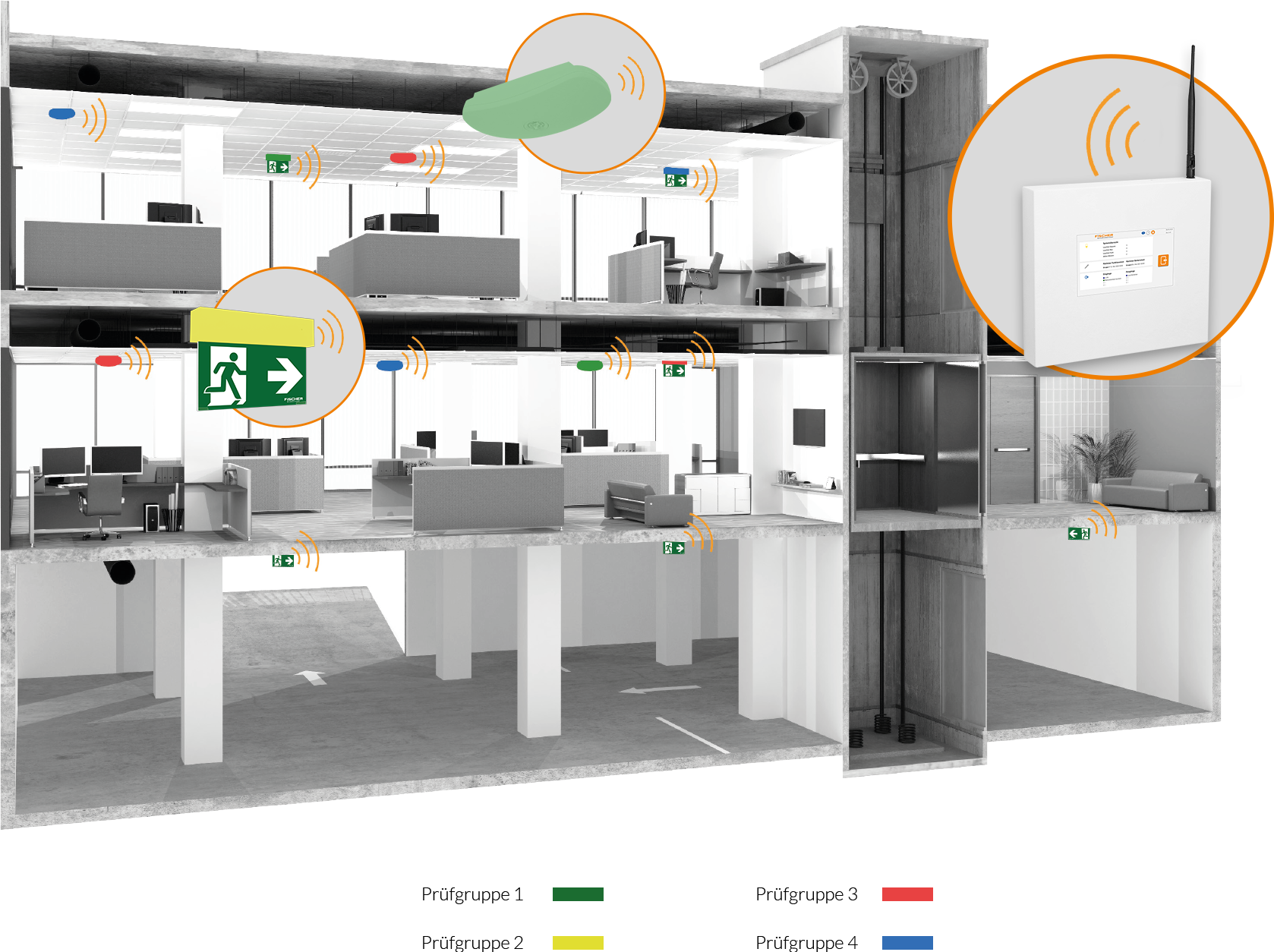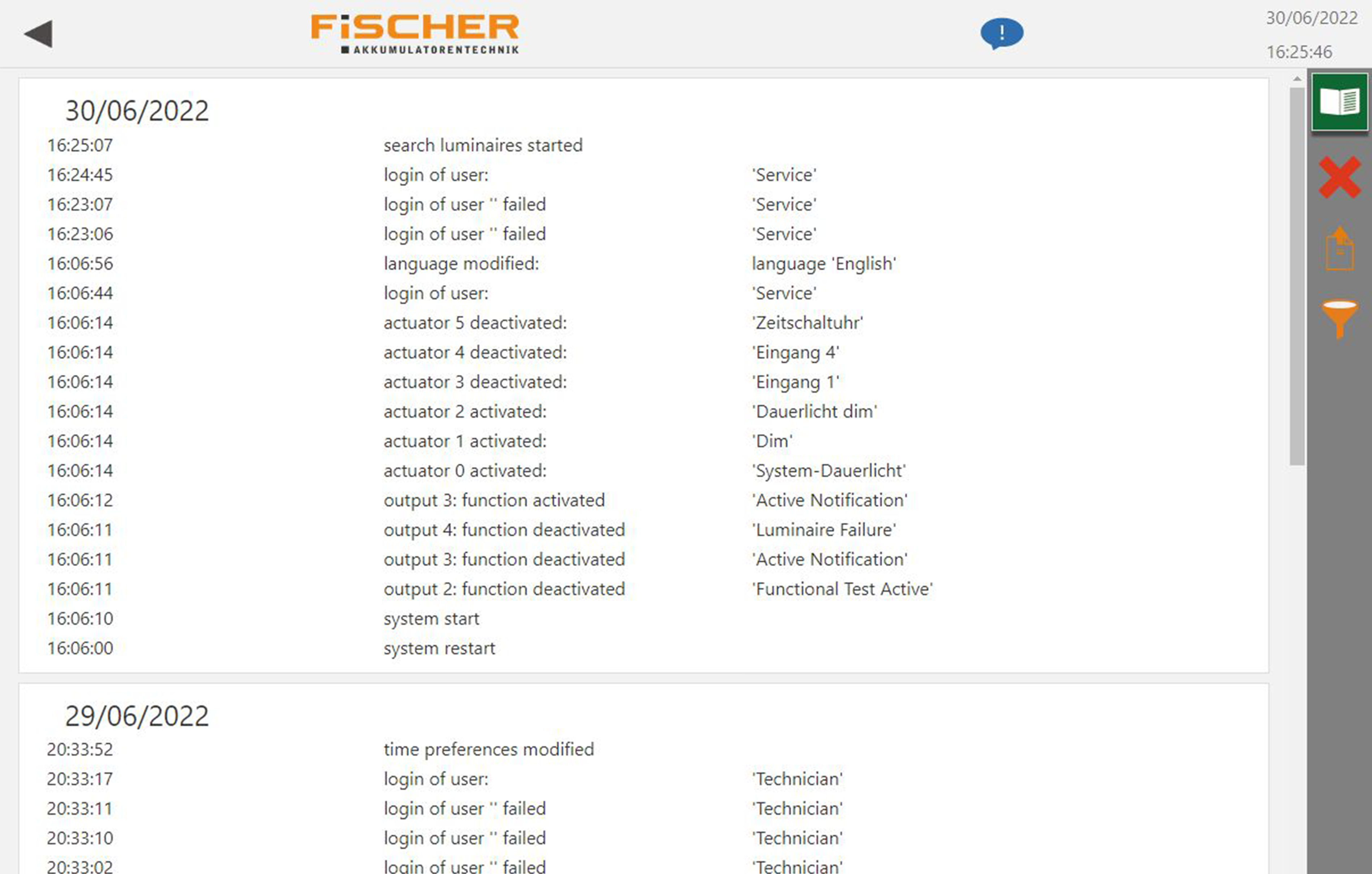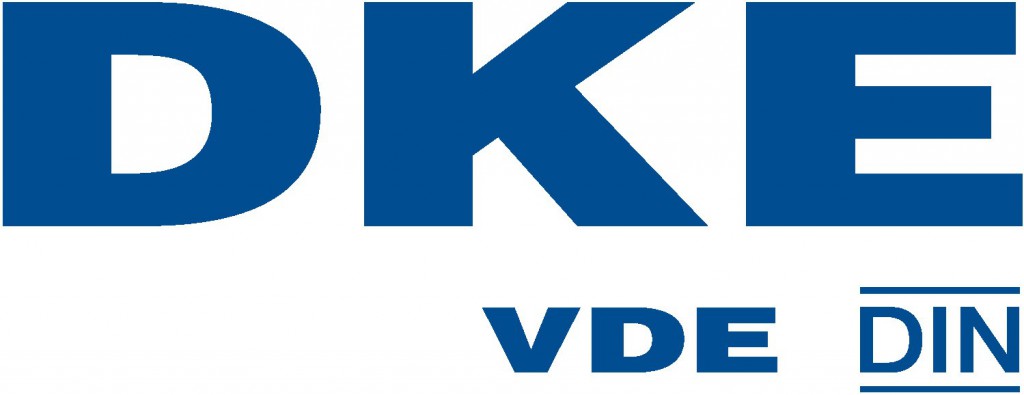m-easyecc3-central
/ Overview / Self-contained Luminaires / easyECC3 / central control
/ Overview / Self-contained Luminaires / easyECC3 / central control
Easy-ECC3
Central, wireless monitoring for self-contained luminaires
Maintain safety and put a stop to forgetting after installation
In many countries, the specification for the central monitoring of self-contained luminaires corresponds to the valid legal situation. However, it should also be a matter of course where there are no corresponding regulations. All too often, self-contained luminaires are no longer checked regularly after installation and safety in the building is no longer fully guaranteed.
Because of this, the ECC3 can:
- monitor the function at a suitable “central” point
- prevent battery operation during downtimes
The FiSCHER  -ECC3 technology faces exactly these two tasks.
-ECC3 technology faces exactly these two tasks.
Wired? No thank you! Fischer  -ECC3
-ECC3
Advantages over wired systems
| ECC2 |  -ECC3* -ECC3* |
|
| Automatic test system ATS-PERC according to IEC62034 | Yes | Yes |
| Switching and dimming of self-contained emergency luminaires | Yes | Yes |
| Integrated network connection / Operation via a web interface | Yes | Yes |
| Subsequent installation in protected objects without the additional introduction of communication lines | No | Yes** |
| Installation wizard with automatic assignment of test groups | No | Yes |
| self-healing network | No | Yes |
*Consists of “M” generation FiSCHER luminaires with ECC3-AddOn, combined with the ECC3 monitoring center
**230 V
The installation wizard
Emergency lighting as easy to set up as a TV
The installation wizard takes over a large part of the otherwise complex tasks for you during commissioning. Escape sign luminaires for marking escape routes are automatically programmed for maintained and emergency luminaires for illuminating escape and rescue routes for non-maintained operation. The installation assistant also automatically arranges the luminaires into up to 16 test groups. This ensures that not all luminaires run through a capacity at the same time. So safety is guaranteed even in the event of a power failure occurring after the capacity test.
Automatic test groups
Setting up an ATS system has never been easier
Depending on the applicable legal situation in the respective country, an annual capacity test is required over the full rated running period. As a result, safe operation can no longer be guaranteed after the capacity test. Compensation measures are required to keep the building in operation. In case self-contained luminaires are used, this can be easily implemented by forming test groups. In this way, the neighboring luminaires of the ones currently being tested take over their task and safety is guaranteed. Here the  -ECC3 supports the installer directly in the critical phase of the installation and carries out the time consuming sorting of the luminaires into test groups completely automatically, thus saving valuable working time.
-ECC3 supports the installer directly in the critical phase of the installation and carries out the time consuming sorting of the luminaires into test groups completely automatically, thus saving valuable working time.
Particularly suitable for cinemas and theatres
Dimmable emergency luminaires
The EC 60364-5-56 requires a manual switch-off device for rooms that can be darkened for operational purposes, even for self-contained luminaires. This rules out the use of
self-con-tained luminaires without ATS-PERC.  -ECC3
enables a manual, wireless shutdown of self-contained luminaires and offers a manual run-on time funktion. An escape route marking with 500 cd/sqm makes the use of an escape and
rescue route safer because the marking can be recognized more quickly. However, this benefi t under normal lighting conditions can be problematic when only low luminance levels are required, such as in a theatre or cinema. To not disturb viewers by a high brightness of the luminaires during the presentation, they should be dimmable. All self-contained FiSCHER luminaires of the “M” generation with an ECC3 Add-On can be can be dimmed from the
-ECC3
enables a manual, wireless shutdown of self-contained luminaires and offers a manual run-on time funktion. An escape route marking with 500 cd/sqm makes the use of an escape and
rescue route safer because the marking can be recognized more quickly. However, this benefi t under normal lighting conditions can be problematic when only low luminance levels are required, such as in a theatre or cinema. To not disturb viewers by a high brightness of the luminaires during the presentation, they should be dimmable. All self-contained FiSCHER luminaires of the “M” generation with an ECC3 Add-On can be can be dimmed from the  -ECC3 control centre in mains operation. In the event of a power failure, the LED of the luminaires immediately ramp up back to the specifi ed target value.
-ECC3 control centre in mains operation. In the event of a power failure, the LED of the luminaires immediately ramp up back to the specifi ed target value.
Digital test logbook
Easy to understand and exportable at any time
Depending on the applicable legal situation in the respective country, it may be mandatory to keep a test logbook that is available on site either physically or as a digital printout at all times.By using the open HTML standard, it is possible for the operator or inspection authorities to export the test results noted in the logbook via the USB 2. 0 port at any time and to process them further on any device.
Just as required by DIN VDE V 0108-100-1, the inspection book for each individual property can be easily exported as a PDF file to be presented to the inspection authorities at any time.
Emergency light blocking during idle times
The maximum safety
Self-contained emergency lighting must not be active during idle periods to prevent unintentional discharge of the batteries. This is to ensure that in the event of a mains failure directly following the operational idle time, the charge level of the batteries in the luminaires is high enough to guarantee their safe operation. You can set self-contained luminaires to the emergency lighting blocking state centrally via the display of the ECC3 control panel.It is also possible to trigger emergency lighting blocking via the
integrated switching input.
The add-on can be retrofitted to all luminaires of the “M” series
Sustainability through retrofitting
With a focus on a long product life and the smallest possible ecological footprint, modularity and retrofittability were important criteria in the development of our current luminaire series. The luminaires of Generation “M” can be operated as self-monitored single-battery luminaires (classification ATS-S according to IEC 62034) virtually out of their outer packaging as standard. By simply plugging in a small, specific additional board, the so-called Add-On, the luminaires can also be upgraded with different, radio-based, central monitoring technologies and then correspond to the classification type PER.
FUNCTIONAL SAFETY
High network stability and range
Functional safety is an elementary component of the  -ECC3. The use of an encrypted radio network means that it is not possible to control luminaires externally once they have been connected to the system. The sub-GHz network frequency used enables high ranges with maximum network stability in the building.
-ECC3. The use of an encrypted radio network means that it is not possible to control luminaires externally once they have been connected to the system. The sub-GHz network frequency used enables high ranges with maximum network stability in the building.
| Technical data | |||||
| Input voltage: | 230 V AC ±10%, 50/60 Hz | ||||
| Protection class: | I | ||||
| Degree of protection: | IP20 | ||||
| Switching inputs and outputs: | 4 potential 24 V DC programmable (NO/NC/1kOhm) | ||||
| Relay output: | 4 potential free (max. 250V AC) | ||||
| Aux: | 3x 24 V DC; 1x 500 mA and 2x 200 mA | ||||
| Network connection: | Integrated web interface | ||||
| Number of luminaires: | max. 200* | ||||
| Test groups: | 16 | ||||
| Dimensions (HxWxD): | 326 x 276 x 41,5 mm | ||||
| Operating temperature: | 0 – 35 °C | ||||
| Housing: | sheet steel | ||||
| Color: | white | ||||
| Mounting: | wall mounting | ||||
*May vary depending on object
System structure
Features and connectivity
-

-
Company headquarters
FiSCHER Akkumulatorentechnik GmbH
Im Taubental 41
41468 Neuss
Germany -
Phone & Email
Switchboard: +49 2131 52310-0
Technical Support: +49 2131 52310-89
Purchase advice and order processing for luminaires and accessories:
Tel: +49 2131 52310-21
Fax: +49 2131 52310-40
Further contact options
E-Mail: info@akkufischer.de -
You can find us here


























